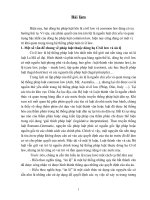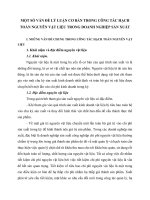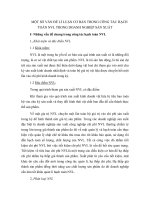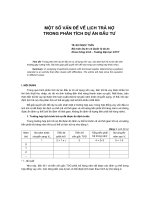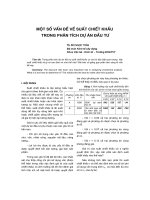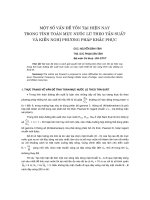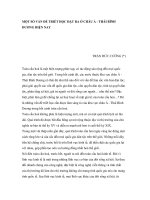Một số vấn đề toán học ẩn chứa trong trò chơi Sudoku (LV thạc sĩ)
Bạn đang xem bản rút gọn của tài liệu. Xem và tải ngay bản đầy đủ của tài liệu tại đây (926.28 KB, 67 trang )
MINISTRY OF
EDUCATION AND TRAINING
VIETNAM ACADEMY OF
SCIENCE AND TECHNOLOGY
GRADUATE UNIVERSITY
OF SCIENCE AND TECHNOLOGY
Nguyễn Thị Nga
SOME MATHEMATICAL ISSUES
BEHIND SUDOKU PUZZLES
MASTER THESIS IN MATHEMATICS
Hanoi - 2018
Confirmation
This thesis was written on the basis of my research works carries
out at Institute of Mathematics, Vietnam Academy of Science and
Technology under the supervision of Dr. Le Xuan Thanh. All results
of other authors that are used in this thesis are cited correctly.
September 12, 2018
The author
Nguyen Thi Nga
Acknowledgements
This thesis was conducted and completed at the Institute of Mathematics, under the guidance of Dr. Le Xuan Thanh. By this occasion,
I would like to express my gratitude and deep respect to Dr. Le Xuan
Thanh, the exemplary teacher who has spent a lot of time and effort
to guide me through this thesis. Thanks to conscientious guidance,
my research skills have been growing up. He introduced me to many
seminars and conferences, as well as helped me a lot in enlarging my
knowledge. His clear and careful characteristics have a significant influence on me in conducting learning, researching, writing scientific
documents. He was the one who instilled on my passion for Applied
Mathematics. He is not only a master in advising students but also
a very warm person in daily life. I always receive sincere and effective advices from him on professional issues, as well as professional
orientation in the future.
I sincerely thank Center for Postgraduate Training and Department of Numerical Analysis and Scientific Computing of Institute of
Mathematics, Vietnam Academy of Science and Technology for creating favorable conditions for me to complete this thesis.
I express my gratitude to everyone from the Institute of Mathematics, who devoted themselves to teaching and creating favorable
conditions for me to complete my master course.
I would also like to thank my friends for their companion and
help. I would like to say my heartfelt gratitude to my family for their
understanding, patience, support during my time at the Institute of
Mathematics.
1
Contents
1 INTRODUCTION
2
2 SUDOKU ENUMERATION
2.1 Completing blocks B1 − B3 . . . . . .
2.2 A simple heuristic enumeration method
2.3 An exact enumeration method . . . . .
2.3.1 Lexicographical catalogue . . .
2.3.2 Enumerating from catalogue . .
2.4 Conclusions . . . . . . . . . . . . . . .
.
.
.
.
.
.
.
.
.
.
.
.
.
.
.
.
.
.
.
.
.
.
.
.
.
.
.
.
.
.
.
.
.
.
.
.
.
.
.
.
.
.
.
.
.
.
.
.
.
.
.
.
.
.
5
6
8
10
12
12
45
3 IP FORMULATIONS FOR SUDOKU
46
3.1 A binary linear programming formulation . . . . . . . . 47
3.2 An integer programming formulation . . . . . . . . . . 49
3.3 Conclusions . . . . . . . . . . . . . . . . . . . . . . . . 52
4 NUMERICAL EXPERIMENTS
4.1 Modeling by ZIMPL . . . . . . .
4.1.1 ZIMPL model for (BLP ) .
4.1.2 ZIMPL model for (N LIP )
4.2 Numerical experiments . . . . . .
4.3 Conclusions . . . . . . . . . . . .
5 CONCLUSIONS
.
.
.
.
.
.
.
.
.
.
.
.
.
.
.
.
.
.
.
.
.
.
.
.
.
.
.
.
.
.
.
.
.
.
.
.
.
.
.
.
.
.
.
.
.
.
.
.
.
.
.
.
.
.
.
.
.
.
.
.
53
54
54
57
59
61
62
2
Chapter 1
INTRODUCTION
Sudoku is a famous puzzle, which is original called Number Place.
In Japanese, Sudoku means “single number”. In its well-known format, a Sudoku puzzle can be described as follows. Give a grid consisting of 9 × 9 squares (cells), which can also be viewed as a composition
of nine 3 × 3 blocks (so-called subgrids). The puzzle rules are:
(1) each cell of grid must be filled by exactly one digit;
(2) only digits from 1 to 9 can be filled in the grid;
(3) each digit appears exactly once in each column, each row, and
each 3 × 3 subgrid.
Usually, a Sudoku puzzle is provided with a partially complete grid,
and the objective is to completely fill the grid. A well-posed Sudoku
puzzle, also called proper Sudoku, has exactly one solution. Figure
1.1 gives an example of a standard 9 × 9 Sudoku puzzle and a solution
for the puzzle.
3
5
8
9
1 6
3
7
4
8
6
1
8 7
2 6
1
6
3
8 5
4 7
2 1
9
8
3
4
8
1
3
5
6
9
7
2
7
5
6
1
9
2
3
4
8
2
9
3
8
7
4
6
1
5
5
6
9
7
3
8
4
2
1
3
4
8
2
1
5
7
6
9
1
2
7
6
4
9
8
5
3
8
3
2
4
6
1
5
9
7
6
1
5
9
8
7
2
3
4
9
7
4
5
2
3
1
8
6
Figure 1.1: A Sudoku puzzle (left) and a solution for it (right).
Howard Garns (March 2nd, 1905 - October 6th, 1989) is an American architect, is most likely considered as the father of the modern
Sudoku. He published the earliest known examples of modern Sudoku
on Dell Magazines in 1979. In April 1984, the puzzle was introduced
on the Japanese paper Monthly Nikolist. The name of the puzzle in
Japanese was “S¨
uji wa dokushin ni Kagiru” (translated “the digits
must be single”), and afterward was abbreviated to Sudoku by Maki
Kaji - the president of Nikoli Co. Ltd., a Japanese puzzle manufacturer. Wayne Gould (born July 3rd 1945 in Hawera, New Zealand) devised a computer program to rapidly produce Sudoku puzzles. Thanks
to his efforts, Sudoku successfully appeared in a local US newspaper.
Then, in November 2004, The Times of London began featuring Sudoku. The puzzle was rapidly spread to other newspapers as a regular
feature.
Despite the simple rules, there are many non-trivial matters and
challenging issues behind Sudoku puzzles. These make Sudoku not
only popular in daily life but also attractive to many mathematicians.
In [6], the authors proved a non-trivial result that the smallest number
of clues in a proper 9 × 9- Sudoku puzzle is 17. Concerning the complexity issue, it had been shown in [8] that solving Sudoku puzzles of
general size n2 × n2 (with n ≥ 3) is NP-complete. There are also a lots
of variants of Sudoku with different sizes and/or additional constraints
4
(see of Sudoku for more details). However, in this thesis we only consider Sudoku puzzles of the
well-known form described above.
In addition to the theoretical issues, having efficient mathematical
models as well as finding fast and accurate algorithms for solving Sudoku puzzles are also attractive topics of interest. In many scheduling
and timetabling problems, there are similar constraints to the ones
of Sudoku. So Sudoku is not only a typical problem in many mathematical specialities (such as combinatorics, complexity, combinatorial
optimization, . . .) but also an important example in mathematical
programming (in senses of both modelling and numerical solutions).
The goal of thesis is to study some mathematical issues behind Sudoku puzzles. We focus mainly on the problem of counting the number
of Sudoku grids, and on how to model Sudoku puzzles as mathematical programs. Apart from this chapter, this thesis is organized in 4
more chapters. Chapter 2 is devoted to the problem of enumarating
Sudoku. In Chapter 3 we present two integer programming models for
solving Sudoku puzzles. Chapter 4 presents some numerical experiments of the mathematical models proposed in Chapter 3. Chapter 5
closes this thesis by some conclusions.
5
Chapter 2
SUDOKU
ENUMERATION
The goal of this chapter is to compute the number, which is denoted
by NS for convenience, of possible solutions for Sudoku. Surprisingly,
no general combinatorial formula for computing that number has been
known until now. In this chapter, based on the ideas in [2, 4], we give
a complete enumeration method for computing NS . For the sake of
the enumeration method, we label the blocks of a Sudoku grid by B1
to B9 as shown in Figure 2.1.
B1
B2
B3
B4
B5
B6
B7
B8
B9
Figure 2.1: Labels of blocks in Sudoku grid.
We first start with the number of ways to complete the first three
6
blocks B1 − B3 . Section 2.1 shows how to compute that number.
This gives the starting point for a simple heuristic method computing
approximately the value of NS . This method is presented in Section
2.2. Then in Section 2.3 we present an exact method to compute the
number NS .
2.1
Completing blocks B1 − B3
We say that a Sudoku grid is of canonical form if the top-left block
B1 is filled as in Figure 2.2.
1
4
2 3
5 6
7
8
9
Figure 2.2: Canonical block.
Let S9 be the group of permutations on the set of nine digits
{1, . . . , 9}. We say that two completely filled Sudoku grids G1 and
G2 are equivalent if G2 is obtained from G1 after applying a permutation f ∈ S9 , or shortly speaking, G2 = f (G1 ). Note that every
non-canonical Sudoku grid is equivalent to a canonical Sudoku grid
via some permutation in S9 . Therefore, each canonical Sudoku grid is
equivalent to |S9 | = 9! Sudoku grids. In other words, if we denote by
NC the number of canonical Sudoku grids, then NS = NC × 9!.
Now we concentrate on considering canonical Sudoku grids. In the
following, by {a, b, c} we indicate the elements a, b, c in any order, and
(a, b, c) in the indicated order. Since the top row of B1 is (1, 2, 3),
there are two cases for the top row of block B2 .
• Case 1 (Pure): It consists of either the second or the third row
of B1 , i.e., either {4, 5, 6} or {7, 8, 9}.
• Case 2 (Mixed): It consists of the three digits in the mixture of
{4, 5, 6} and {7, 8, 9}.
7
More precisely, all possible top rows of blocks B2 and B3 are shown in
Table 2.1.
No. Top row of B2 Top row of B3
1
{4, 5, 6}
{7, 8, 9}
2
{7, 8, 9}
{4, 5, 6}
3
{4, 5, 7}
{6, 8, 9}
4
{4, 5, 8}
{6, 7, 9}
5
{4, 5, 9}
{6, 7, 8}
6
{4, 6, 7}
{5, 8, 9}
7
{4, 6, 8}
{5, 7, 9}
8
{4, 6, 9}
{5, 7, 8}
9
{5, 6, 7}
{4, 8, 9}
10
{5, 6, 8}
{4, 7, 9}
11
{5, 6, 9}
{4, 7, 8}
12
{6, 8, 9}
{4, 5, 7}
13
{6, 7, 9}
{4, 5, 8}
14
{6, 7, 8}
{4, 5, 9}
15
{5, 8, 9}
{4, 6, 7}
16
{5, 7, 9}
{4, 6, 8}
17
{5, 7, 8}
{4, 6, 9}
18
{4, 8, 9}
{5, 6, 7}
19
{4, 7, 9}
{5, 6, 8}
20
{4, 7, 8}
{5, 6, 9}
Case
Pure
Pure
Mixed
Mixed
Mixed
Mixed
Mixed
Mixed
Mixed
Mixed
Mixed
Mixed
Mixed
Mixed
Mixed
Mixed
Mixed
Mixed
Mixed
Mixed
Table 2.1: Possible top rows of blocks B2 and B3 .
In the first pure case (No.1 in Table 2.1), blocks B2 and B3 can
be completed together as in Figure 2.3. Since each set {a, b, c} corresponds to 3! = 6 permutations of its elements and there are 6 rows of
blocks B2 , B3 , this leads to 66 different configurations of B2 , B3 . The
same result holds for the second pure case (No.2 in Table 2.1).
8
1
2
3 {4, 5, 6} {7, 8, 9}
4
5
7
8
6 {7, 8, 9} {1, 2, 3}
9 {1, 2, 3} {4, 5, 6}
Figure 2.3: Completing B1 − B3 in the first pure case.
For the first mixed case (No.3 in Table 2.1), by Sudoku rules, blocks
B2 and B3 can be completed together as in Figure 2.4. Here, a, b, c
stand for 1, 2, 3. Each choice of a determines a choice for {b, c}, and
there are 3 choices for a ∈ {1, 2, 3}. Again, each row of blocks B2 and
B3 in Figure 2.4 corresponds to 3! = 6 permutations of its filled digits,
and there are 6 rows of these two blocks. Therefore, Figure 2.4 stands
for 3 × 66 different configurations of B2 , B3 . The same result holds for
the other mixed cases (No. 4-20 in Table 2.1).
1
2
4
5
3 {4, 5, 7} {6, 8, 9}
6 {8, 9, a} {7, b, c}
7
8
9 {6, b, c} {4, 5, a}
Figure 2.4: Completing B1 − B3 in the first mixed case.
To summarize, we have 2 pure cases (each gives 66 different configurations of blocks B2 − B3 , and 18 mixed cases (each gives 3 × 66
different configurations of blocks B2 − B3 ). Therefore, in total, the
number of different configurations of blocks B2 − B3 in canonical Sudoku grids is
2 × 66 + 18 × 3 × 66 = 2612736.
This means that the number of possibilities for the three blocks B1 −B3
(in which B1 is not necessary in canonical form) is
9! × 2612736 = 948109639680.
2.2
A simple heuristic enumeration method
For convenience, we recall the rules of Sudoku puzzles:
9
(i) each digit from 1 to 9 appears exactly once in each block B1 −B9 ;
(ii) each digit from 1 to 9 appears exactly once in each row of
Sudoku grid;
(iii) each digit from 1 to 9 appears exactly once in each column of
Sudoku grid.
Each block consists of 9 cells, therefore we have 9! ways to fill all
the digits 1, . . . , 9 in each block. This results in Nb = (9!)9 ways to fill
in all blocks B1 to B9 satisfying rule (i).
We have known from Section 2.1 that 948109639680 is the number
of ways to fill in the three blocks B1 − B3 so that each block has the
digits 1, . . . , 9 and also each row has the digits 1, . . . , 9. The same
results hold true for blocks B4 − B6 , and for blocks B7 − B9 . Therefore
the number of ways to fill in all blocks B1 − B9 in such a way that
satisfies rules (i) and (ii) is Nr = 9481096396803 .
So, in Nb possibilities of filling in blocks B1 − B9 satisfying block
rule (i), there are Nr possibilities that also satisfy row property (ii),
that correspond to a proportion of
9481096396803
Nr
=
.
p=
Nb
(9!)9
Similarly, in Nb possibilities of filling in blocks B1 −B9 satisfying block
rule (i), there are 9481096396803 possibilities of filling in blocks B1 −B9
satisfying both block rule (i) and column rule (iii), that correspond
to the same proportion p.
A solution to Sudoku is just one of the Nb grids satisfying rule
(i) that has both the row property (ii) and column property (iii).
Assuming the row and column properties are independent, the total
number of solutions to Sudoku would be
9481096396803
Nb × p = (9!) ×
(9!)9
9481096396806
=
(9!)9
(9!)6 × 566 × 636
=
(9!)9
2
9
2
10
566 × 636
=
(9!)3
= 6657084616885512582463.488
≈ 6.657 × 1021 .
In fact, the row property (ii) and column property (iii) are not independent, so the number computed above cannot be the correct answer.
It is even not an integer! However, after the computation in the next
section, we will see that this number is really close to the exact answer
(with a difference is just 0.2%).
2.3
An exact enumeration method
In this section, we will prove that the exact number of Sudoku
grids is
NS = 6670903752021072936960 ≈ 6.671 × 1021 .
To have an impression about how big NS is, let us compute how large
of computer memory to save all these number of Sudoku grids. Table
2.2 gives the binary representation of each digit from 1 to 9, which in
turn gives the number of bits to save each of the digits in computer
memory.
Digit
Expression
Binary representation Number of bits
0
1
1×2
12
1
2
1 × 21 + 0 × 20
102
2
1
0
3
1×2 +1×2
112
2
4
1 × 22 + 0 × 21 + 0 × 20
1002
3
5
1 × 22 + 0 × 21 + 1 × 20
1012
3
6
1 × 22 + 1 × 21 + 0 × 20
1102
3
2
1
0
7
1×2 +1×2 +1×2
1112
3
8
1 × 23 + 0 × 22 + 0 × 21 + 0 × 20
10002
4
3
2
1
0
9
1×2 +0×2 +0×2 +1×2
10012
4
Table 2.2: Binary representations of digits from 1 to 9.
11
Since each digit from 1 to 9 appears exactly 9 times in a Sudoku
grid, it follows from Table 2.2 that the number of bits needed to encode
a Sudoku grid is
9 × (1 + 2 × 2 + 3 × 4 + 4 × 2) = 225.
Following the data measure given in Table 2.3, to store all Sudoku
grids we need the computer memory space of
NS × 225
= 1.66639 × 108 (petabytes).
5
8 × 1024
Measure
Symbol Equivalence
1 byte
1B
8 bits
1 kilobyte
1 KB
1024 B
1 megabyte 1 MB
1024 KB
1 gigabyte
1 GB
1024 MB
1 terabyte
1 TB
1024 GB
1 petabyte
1 PB
1024 TB
Table 2.3: Units in data measurement.
Now we discuss in detail the computation for NS . Thanks to the
discussion in Section 2.1, from now we restrict our consideration to
canonical Sudoku grids. We also know from Section 2.1 that there are
2612736 possible configurations of B2 − B3 in canonical Sudoku grids.
We partition the configurations of B2 and B3 into classes as follows.
• Two configurations of B2 and B3 are in the same class if they
have the same number of ways of completing to a full valid Sudoku grid.
We then look at operations that do not change the number of Sudoku
grids. The partition of the configuration of B2 and B3 into classes help
us to reduce the number of possibilities which we need to consider in
2612736 possibilities for B2 − B3 .
12
2.3.1
Lexicographical catalogue
We classify all 2612736 configurations of B2 − B3 as follows.
• Within B2 and within B3 , we permute the columns so that the
entries in the top row are in increasing order.
• Exchange B2 and B3 if necessary so that B2 is before B3 in
lexicographical order with respect to their top rows.
Concerning the action in the second step, when we permute B1 ,
B2 and B3 in any way, then B1 is changed. But we can relabel to
put it back into canonical form. Hence, if we exchange B2 and B3 ,
then every way of filling in B2 − B3 gives us a unique way to complete
B3 − B2 to complete grid (just exchange between B5 and B6 , and B8
and B9 in the former configuration).
Concerning the action in the first step, similar to the second step,
each way of completing from a configuration of (B2 , B3 ) to a complete
Sudoku grid gives a unique way to complete its column permutation
to a complete Sudoku grid (just perform the same permutation on the
column in a complete grid).
There are 3! ways to permute the columns in each block B2 and B3
from the first step, so we have (3!)2 = 36 grids which with the same
number of ways of completing. From the second step, permutation
of 2 blocks B2 and B3 lead to double number of possibilities may be
reduced of the number of way of completing of (B2 , B3 ). Overall, we
can reduce 36×2 = 72 times in 2612736 possibilities mentioned above.
Thus, we only need to consider 2612736/72 = 36288 possibilities for
our catalogue.
2.3.2
Enumerating from catalogue
At this point, our catalogue consists of 36288 configurations of
blocks B2 − B3 , that are lexicographically ordered (as described in
Section 2.3.1). Our framework to handle with the catalogue is given
in Algorithm 1.
13
Algorithm 1 Enumerating from catalogue
1: Input: Lexicographically ordered catalogue of configurations of
B2 − B3
2: Initialization: Color all configurations in catalogue
3:
numberOfClass ← 0
4: while catalogue has some color configuration do
5:
Let α be the first colored configuration in catalogue
6:
Find Cα := the class of all configurations in catalogue that are
equivalent to α
7:
Uncolor all configurations in Cα
8:
numberOfClass ← numberOfClass + 1
9:
Compute nα := the number of ways to complete from α to full
Sudoku grid
10: end while
After executing Algorithm 1, we get a list C of configurations of
B2 − B3 , each of the configurations in C is a representative in its
equivalent class. It follows from our discussion that
|Cα | = 36288,
α∈C
and the number of canonical Sudoku grids is computed by
nα |Cα |.
NC = 72
(2.1)
α∈C
Computing |Cα | and nα for each class representative α ∈ C are the key
procedures in Algorithm 1, respectively corresponding to the steps in
line 6 and line 9 of the algorithm pseudo-code. We now discuss the
procedures in detail.
1. Finding equivalent class of a given configuration in the catalogue
We note that there are four types of operations that can be applied
to B1 − B3 preserving the number of completions from these three
blocks to a full grid:
14
• type 1: permuting the columns within each block B1 , B2 , B3 ,
• type 2: permuting the whole block B1 , B2 , B3 ,
• type 3: permuting the cells within each column of B1 , B2 , B3
(provided that the obtained configuration does not break the
Sudoku rules),
• type 4: relabelling (i.e. applying a permutation f ∈ S9 to a
configuration of B1 − B3 ).
The first two types are discussed in Section 2.3.1, while the operations
of type 4 are already mentioned in Section 2.1. These four types of
operations suggest the following exhaustive way to find the equivalent
class Cα of a chosen configuration α in the catalogue.
Start from the chosen configuration α. Let us consider all configurations of B1 − B3 obtained from α by applying possible operations
of types 1-3. Then for each obtained configuration, we apply an operation of type 4 in order to transform block B1 to canonical form. We
furthermore apply operations of types 1-2 in order to transform blocks
B2 − B3 to satisfy the lexicographical conditions mentioned in Section
2.3.1, i.e., the entries in the top row of B2 , B3 are in increasing order
and B2 is before B3 in lexicographical order with respect to their top
rows. If we are successfully performing these operations, then the last
obtained configuration belongs to the equivalent class of α.
To better understand this process, let us consider some illustrative
examples.
Example 1. Assume that B1 − B3 are filled as in Figure 2.5. Since
block B1 is in canonical form, and blocks B2 − B3 are in the lexicographical order, this configuration belongs to our catalogue.
1 2 3 4 8 9 5 6 7
4 5 6 1 2 7 3 8 9
7 8 9 3 5 6 1 2 4
Figure 2.5: Configuration 1.
15
Permuting the first and the second rows of all the blocks, we obtain
the configuration in Figure 2.6.
4 5 6 1 2 7 3 8 9
1 2 3 4 8 9 5 6 7
7 8 9 3 5 6 1 2 4
Figure 2.6: Configuration 1 after permuting the first two rows.
In this configuration, B1 is not in the canonical form, so we need a
relabelling operation to transform it back to canonical form. Relabelling 1 ↔ 4, 2 ↔ 5, 3 ↔ 6 in all the three blocks B1 − B3 , we obtain
the configuration in Figure 2.7.
1 2 3 4 5 7 6 8 9
4 5 6 1 8 9 2 3 7
7 8 9 6 2 3 4 5 1
Figure 2.7: Configuration 1 after permuting the first two rows and
relabelling.
In configuration in Figure 2.7, block B1 is in canonical form, and
blocks B2 − B3 are in the lexicographical order. Thus, this configuration belongs to our catalogue. Furthermore, since all operations we
have applied are of types 3-4, this obtained configuration in Figure
2.7 has the same number of completions to the full Sudoku grid as the
configuration 1 in Figure 2.5). Therefore, these two configurations are
in the same equivalent class.
Example 2. Start from the configuration of B1 −B3 in 2.5, permute
the first two columns of B1 , we get the configuration in Figure 2.8.
16
2 1 3 4 8 9 5 6 7
5 4 6 1 2 7 3 8 9
8 7 9 3 5 6 1 2 4
Figure 2.8: Configuration 1 after permuting the first two columns of
B1 .
In this configuration, block B1 is not in the canonical form. Relabelling
1 ↔ 2, 4 ↔ 5, 7 ↔ 8 in all the three blocks B1 − B3 , we obtain the
configuration in Figure 2.9.
1 2 3 5 7 9 4 6 8
4 5 6 2 1 8 3 7 9
7 8 7 3 4 6 2 1 5
Figure 2.9: Configuration 1 after permuting the first two columns of
B1 and relabelling.
This configuration belongs to our catalogue since block B1 is in canonical form, and blocks B2 − B3 are in the lexicographical order. So it
also belongs to the equivalent class of configuration in Figure 2.5.
Example 3. Assume that B1 − B3 are filled as in Figure 2.10. It is
obvious that this is one configuration in our catalogue.
1 2 3 4 5 8 6 7 9
4 5 6 1 7 9 2 3 8
7 8 9 2 3 6 1 4 5
Figure 2.10: Configuration 2.
Permuting the first two columns of B1 , we get the configuration in
Figure 2.11.
17
2 1 3 4 5 8 6 7 9
5 4 6 1 7 9 2 3 8
8 7 9 2 3 6 1 4 5
Figure 2.11: Configuration 2 after permuting the first two columns of
B1 .
By relabelling 1 ↔ 2, 4 ↔ 5, 7 ↔ 8 we transform B1 back to canonical
form. However, B2 and B3 are not in lexicographical order (see Figure
2.12).
1 2 3 5 4 7 6 8 9
4 5 6 2 8 9 1 3 7
7 8 9 1 3 6 2 5 4
Figure 2.12: Transform configuration in Figure 2.11 to canonical
form.
So we need to permute the first two columns of B2 to get a configuration whose B2 − B3 are in lexicographical order (see Figure 2.13).
1 2 3 4 5 7 6 8 9
4 5 6 8 2 9 1 3 7
7 8 9 3 1 6 2 5 4
Figure 2.13: A configuration obtained from Configuration 2.
With the similar arguments to the previous examples, this configuration belongs to the equivalent class of Configuration 2.
Example 4. We again consider the configuration of B1 −B3 given in
Figure 2.5. We notice the positions of 1 and 4 in B1 and B2 . Permuting
the cells containing the digits 1 and 4 within the first and the fourth
columns, we get the configuration in Figure 2.14.
18
4 2 3 1 8 9 5 6 7
1 5 6 4 2 7 3 8 9
7 8 9 3 5 6 1 2 4
Figure 2.14: Configuration 1 after permuting positions of 1 and 4 in
the first columns of B1 and B2 .
In configuration in Figure 2.14, block B1 is not in canonical form.
Hence, we have to relabel 1 ↔ 4 to transform B1 back to canonical
form, and obtain the configuration as in Figure 2.15.
1 2 3 4 8 9 5 6 7
4 5 6 1 2 7 3 8 9
7 8 9 3 5 6 4 2 1
Figure 2.15: Configuration obtained after relabelling 1 ↔ 4 in Figure
2.14.
Configuration in 2.15 satisfies the 2 rules of configurations in our catalogue (that are, block B1 is in canonical form, and blocks B2 − B3 are
in the lexicographical order). So configuration in Figure 2.5 and configuration in Figure 2.15 are equivalent and they belong to the same
equivalent class.
2. Completing from a given configuration of B1 − B3 to full Sudoku
grid
In Step 9 of Algorithm 1, we need to compute the number of ways
to complete a full Sudoku grid from a given configuration α of blocks
B1 − B3 . In principle, we can try all possible ways to fill the remaining
blocks B4 −B9 and see which are Sudoku grids. However, we can speed
up this process by insisting that the first column of blocks B4 and B7
is lexicographically ordered. More precisely, by permuting the middle
three rows of the grid, we can assume that the entries on the first
column of B4 are in numerical order, and similarly for B7 . We can
also exchange the middle three rows and the last three rows of the
19
grid so that B4 is before B7 in lexicographical order with respect to
their first columns). By the same arguments as in Section 2.3.1, this
helps to speed up our calculation by a factor of 72.
Mathematically speaking, let Dα be the set of all configurations of
B1 − B3 , B4 , B7 in which B1 − B3 are given by α and B4 , B7 are in
lexicographical order. Let n∗α be the number of ways to complete a
full Sudoku grid from all configurations in Dα . Then we have
nα = 72n∗α .
(2.2)
For each configuration in Dα we try all possible ways to fill the
remaining blocks B5 , B6 , B8 , B9 by using the idea of backtracking algorithm. That is, we first list all possibilities of filling the digit 1 into
these remaining blocks. Then for each of the possibilities, we list all
possibilities of filling the digit 2 into the remaining cells, and so on.
If for some digit a we could not find any possibilities for filling the
next digit a + 1 into these blocks (so that the Sudoku rules are not
violated), then we skip the current possibility of filling the digit a and
come to the next possibility.
We now have all necessary materials for Algorithm 1. In Code 1
we give the code for this algorithm in C++ programming language.
1
2
3
Code 1: C++ code to enumerate equivalent classes in catalogue.
/* This code is written by Nguyen Thi Nga
based on the code of Ed Russell from
http :// www . afjarvis . staff . shef . ac . uk / sudoku /
equiv . c */
4
5
6
/* The aim of this code is to give information
of
44 equivalent classes of Sudoku grids . */
7
8
9
/* Each class consists of B2 - B3 ’s
configurations that have
the same number of ways to complete Sudoku grid
.
20
10
Block B1 is in canonical form . */
11
12
13
14
15
16
17
18
19
/* A representative ( rep for short )
is a way of filling digits to 6 columns of
blocks B2 - B3 .
Each of such columns consists of three digits (
a, b, c)
which is represented by an integer of value
a * 16^2 + b * 16 + c
( i . e . the integer abc in hexadecimal system ) .
We choose the representation in hexadecimal
system
because we may need 4 bits to represent a digit
. */
20
21
22
23
24
25
26
27
28
/* Each representative is stored as an array of
7 integers
rep [0 -6] , in which the first 6 integers rep
[0 -5] correspond to
the hexadecimal representations of 6 columns of
B2 - B3 ,
while rep [6] is the number of B2 - B3 ’s
configurations
that map to this representative .
Furthermore , for the sake of listing the
representatives ,
we impose rep [0] < rep [1] < rep [2] , rep [3] <
rep [4] < rep [5] ,
and rep [0 ,1 ,2] < rep [3 ,4 ,5] ( in lexicographical
order ) . */
29
30
31
32
33
/* Printed information of each class consist of
class index , a class representative ,
number of configurations of B2 - B3 in the class ,
number of ways to complete Sudoku grids
21
34
from a configurations of B2 - B3 in the class . */
35
36
37
38
#i n c l u d e < stdio .h >
#i n c l u d e < stdlib .h >
#i n c l u d e < memory .h >
39
40
41
#d e f i n e NREP 36288
// number of
representatives ( reps )
#d e f i n e NREPX 22266
// number of reps after
a reduction
42
43
44
// Define a function to swap values of two
integers
#d e f i n e SWAP (A , B ) { i n t t = A ; A = B ; B = t ; }
45
46
47
// Shorten the name of data type unsigned int
(32 bits )
typedef unsigned i n t uint32 ;
48
49
50
51
52
53
// Some arrays
s t a t i c i n t rep [ NREP ][7];
s t a t i c i n t colour [ NREP ];
s t a t i c uint32 tmpl [9][16];
s t a t i c i n t ntmpl [9];
54
55
56
// Some variables
s t a t i c i n t grand_total_hi , grand_total_lo ;
57
58
/* Some miscellaneous utility functions */
59
60
61
62
63
// Use an integer to represent a set of three
digits
s t a t i c i n t pack ( i n t a , i n t b , i n t c ) {
i n t packme [10] = {0};
i n t packed = 0;
22
int i;
packme [ a ] = 1;
packme [ b ] = 1;
packme [ c ] = 1;
f o r ( i =1; i <=9; i ++)
i f ( packme [ i ] == 1)
packed = packed * 16 + i ;
return packed ;
64
65
66
67
68
69
70
71
72
}
73
74
75
76
77
78
79
80
/* Function to compare the digit parts of two
reps a and b .
It return a negative value if
a is before b in the lexicographical order . */
s t a t i c i n t qsrepcmp ( const void *a , const void *
b) {
return memcmp (a , b , 6 * s i z e o f ( i n t ) ) ;
}
81
82
83
84
85
86
87
/* Function to re - order the digit part of a
representative
for the sake of listing , i . e . to satisfy
conditions
rep [0] < rep [1] < rep [2] , rep [3] < rep [4] < rep
[5] ,
and rep [0 ,1 ,2] < rep [3 ,4 ,5] ( in lexicographical
order ) . */
s t a t i c void RepOrder ( i n t * rep ) {
88
89
90
91
92
// Re - order the entries in the top row of B2
i f ( rep [0] > rep [1])
SWAP ( rep [0] , rep [1]) ;
i f ( rep [0] > rep [2])
